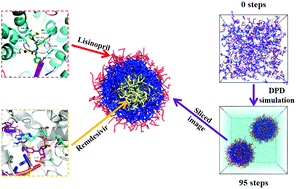Structure-aided ACEI-capped remdesivir-loaded novel PLGA nanoparticles: toward a computational simulation design for anti-SARS-CoV-2 therapy†
Abstract
The sudden arrival of novel coronavirus disease 2019 (COVID-19) has stunned the world with its rapidly spreading virus. Remdesivir, a broad spectrum anti-viral drug, is now under in vitro and in vivo investigation as a potential agent against SARS-CoV-2. However, the results of this therapy were recently equivocal due to no significant benefit in the clinical trial. Herein, combination molecular docking with dissipative particle dynamics (DPD) simulations is used to theoretically design angiotensin-converting enzyme inhibitor (ACEI)-containing remdesivir-loaded PLGA nanoparticles (NPs) for anti-SARS-CoV-2 therapy. Based on the therapeutic and lung protective effect of ACEI, the classical lisinopril molecule covalently grafted onto PLGA (L–PLGA) has been used to encapsulate remdesivir. A binding model is used to confirm the interactions between lisinopril and ACE on the surface of cells, as well as remdesivir and its intracellular targeting protein (RNA-dependent RNA polymerase (RdRp)). Furthermore, DPD simulations are applied to study the nano-aggregation of drug-free L–PLGA, and remdesivir loaded in L–PLGA. The lisinopril molecules were directly demonstrated to be on the surface of L–PLGA NPs. Molecular docking proved that hydrogen bonding was decisive for the encapsulation of remdesivir. With an increase in concentration, remdesivir loaded L–PLGA formed spherical NPs, and then underwent precipitation. Similar to the above conditions, high remdesivir loading was also observed to cause precipitation formation. Thus, the optimized remdesivir NPs in our study give insights into a rational platform for formulation design against this global pandemic.


 Please wait while we load your content...
Please wait while we load your content...